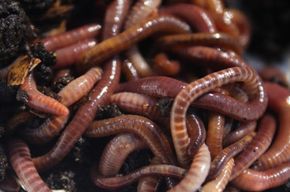Organic Composting with Red Wiggler Worms - Boost Your Garden's Development
Organic Composting with Red Wiggler Worms - Boost Your Garden's Development
Blog Article
Red Wiggler Worms Demystified: Opening the Tricks of Vermiculture for Greener Living and Nutrient-Rich Dirt
In the realm of lasting methods for enhancing dirt top quality and promoting eco-conscious living, red wiggler worms play an essential yet often neglected function. These modest animals have the amazing ability to change natural waste into nutrient-rich spreadings that act as a powerful natural plant food. By delving into the globe of vermiculture, one can reveal a wide variety of advantages that extend far past standard composting techniques. Comprehending the intricacies of looking after these worms, enhancing their setting, and harnessing their spreadings can bring about a greener way of living and healthier dirt for plants to flourish.
The Duty of Red Wiggler Worms
Red Wiggler worms play an essential function in composting systems by effectively breaking down organic matter into nutrient-rich spreadings. These ravenous eaters consume a variety of natural materials, such as kitchen scraps, yard waste, and paper products. As they feed, the worms' digestion procedures damage down the organic matter into a penalty, dark, and nutrient-dense material recognized as worm spreadings or vermicompost.
The castings generated by Red Wiggler worms are highly valuable for soil health and wellness and plant development. They are rich in crucial nutrients like phosphorus, potassium, and nitrogen, which are essential for sustaining healthy and balanced plant advancement. In addition, worm castings have advantageous microbes and enzymes that assist enhance soil structure, increase water retention, and enhance nutrient uptake by plants.
Benefits of Vermicomposting

It boosts soil framework, improves soil oygenation, and increases soil dampness retention. Vermicompost additionally enriches the dirt with crucial nutrients like nitrogen, phosphorus, and potassium, promoting plant development and total dirt fertility.
Furthermore, vermicomposting assistances lasting gardening practices by supplying a all-natural and chemical-free alternative to synthetic fertilizers. Red Wiggler Worms. This ecologically pleasant approach not only enriches the soil however additionally helps in reducing reliance on unsafe chemicals, promoting a greener and more lasting way of gardening
Establishing a Worm Container
When establishing a worm bin for vermicomposting, proper arrangement is crucial to make sure the success of the composting procedure. The initial step in setting up a worm container is choosing an ideal container. This can be a plastic container or wood box that provides enough room for the worms to relocate about and has correct water drainage openings to protect against waterlogging. Next, a bedding product such as shredded paper, cardboard, or coconut coir need to be included in the container. This bed linen supplies a comfortable environment for the worms and helps maintain dampness degrees.
After adding the bedding, present the red wiggler worms to the container. It is suggested to start with a tiny number of worms and progressively boost as they multiply. The worms should after that be supplied with food scraps such as fruit and vegetable peels, coffee premises, and eggshells. It is necessary to prevent including meat, milk, oily, or salty foods to stop attracting pests and producing undesirable odors.
Regularly monitor the dampness levels and temperature level in these details the worm container to guarantee optimal problems for the worms. With proper arrangement and upkeep, the worm bin will efficiently transform organic waste right into nutrient-rich compost for your plants and garden.
Collecting Worm Spreadings
To successfully collect nutrient-rich worm castings from your vermicomposting system, a systematic harvesting method is necessary. When it comes time to harvest the worm castings, there are a couple of key steps to follow to make sure an effective process.

Troubleshooting Common Issues
Recognizing and dealing with common difficulties that may occur during the vermicomposting process is important for preserving a effective and healthy and balanced worm container. One typical issue that vermicomposters encounter is overfeeding. Including excess food scraps can bring about an accumulation of wetness and acidity in the worm bin, potentially harming the worms. To prevent this, feed the worms in moderation, making sure that the food scraps are sufficiently broken down before adding more. Another concern is undesirable odors rising from the worm bin. Foul scents suggest anaerobic visit their website conditions, normally brought on by overwatering or inadequate ventilation. To treat this, change the wetness degrees by including dry bed linen products like shredded newspaper or cardboard and rise aeration by transforming the bed linen frequently.
Furthermore, if the worm population is decreasing or the worms appear harmful, maybe as a result of ecological stress factors such as extreme temperatures or pH levels. Keeping an eye on these elements and making required adjustments is vital for the health of the worms. By fixing these usual issues immediately, vermicomposters can make certain a smooth and successful vermicomposting procedure while preserving a thriving worm population.

Verdict
Finally, red wiggler worms play a critical duty in vermiculture by damaging down natural issue right into nutrient-rich soil. The benefits of vermiculture include greener living and enhanced soil quality. Setting up a worm bin is important for successful vermiculture, and harvesting worm castings offers useful garden compost for horticulture. By recognizing and repairing usual problems, individuals can unlock the secrets of vermiculture for sustainable living and much healthier dirt.
As they feed, the worms' digestion processes damage down the natural matter into a fine, dark, and nutrient-dense product recognized as worm spreadings or vermicompost.
The castings generated by Red Wiggler worms are extremely useful for dirt wellness and plant growth. Including excess food scraps can lead to an accumulation of wetness and acidity in the worm container, potentially hurting the worms.Additionally, if the worm population is decreasing or the worms appear undesirable, it might be due to ecological stress factors such as extreme temperatures or pH degrees. Establishing look what i found up a worm container is necessary for successful vermiculture, and collecting worm castings supplies important garden compost for gardening.
Report this page